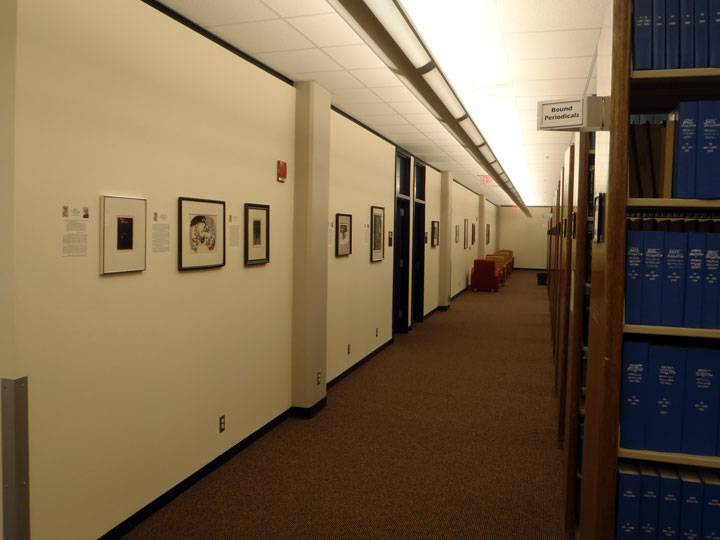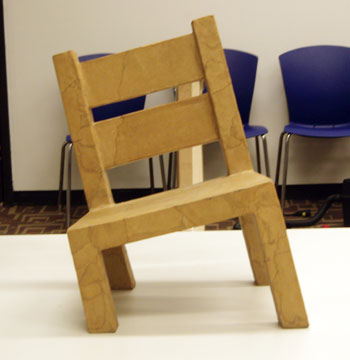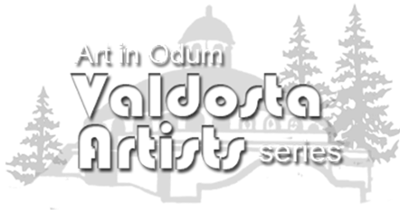Art in Odum
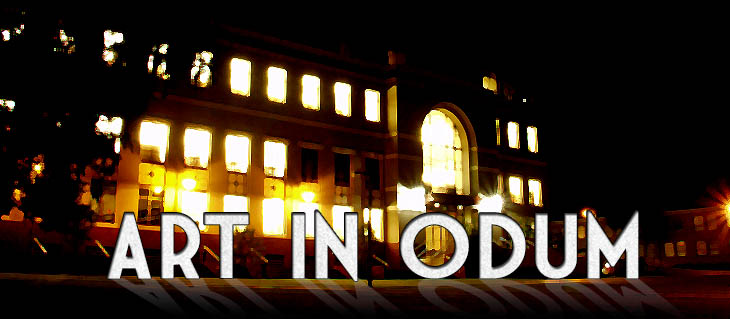
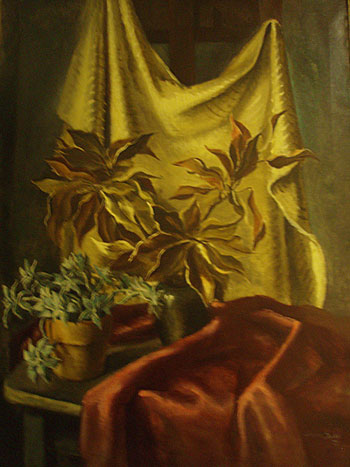 Why Art?
Why Art?
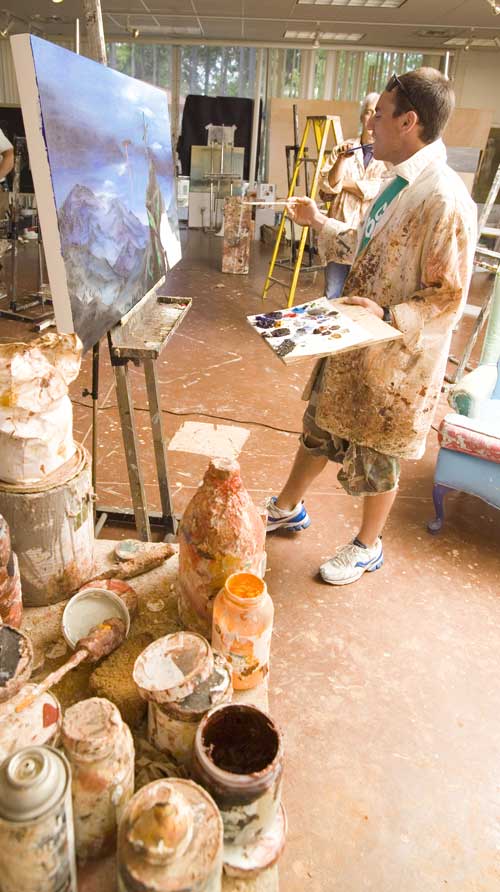 When we began the 2+ year renovation of what we called the Old Building (the North Side of the Library), we had to remove all of the pictures/art/plaques hanging in the library. For the Art mainly that was the Dodd Collection, a set of paintings and prints that was given to us in 1978. As we took it down and packed it up, we were rather appalled at the condition of the paintings and we recognized some of the artists. So we packed it away with a resolution to clean it before it went back up.
When we began the 2+ year renovation of what we called the Old Building (the North Side of the Library), we had to remove all of the pictures/art/plaques hanging in the library. For the Art mainly that was the Dodd Collection, a set of paintings and prints that was given to us in 1978. As we took it down and packed it up, we were rather appalled at the condition of the paintings and we recognized some of the artists. So we packed it away with a resolution to clean it before it went back up.
During this period, we received, based on a recommendation from the Department of Art & Design, a donation of Large Paintings/Drawings/Sculpture from New York artist Ross Rosenberg. We cleaned, photographed, described and rolled up the canvases thinking we really should exhibit them some day.
Then, the university began an Art Funding Pool Committee to advise the campus on acquisition and policies about the University's Art holdings and provide funds to acquire art.
Our first project, for the University Art Committee, was an inventory of campus art. This was created and handled by the VSU Archives and led to a lot of research about our art. Turns out the library has by far the largest Art Collection in the University. In fact when you put the library's and the archives' holdings together we have enough for a small museum.
When the renovation was complete, the Library Art Committee formed and started a rather ambitious project, with some funding from the Art Funding Pool Committee for framing and stabilization, especially of the Rosenberg pieces. We cleaned, varnished, researched, talked to artists, arranged, wrote....It's what we did from April through early August, 2011. We worked with the VSU carpenters to hang the pieces securely and build the sculpture bases. We worked with Gallery Director Julie Bowland to hang and present the works to gallery specs.
In 2010, Mr. William Mobley IV, a generous donor who, through his selections at Library of Congress had brought Odum Library almost one million dollars worth of books, passed away. His friends and family made donations to a special fund in Odum Library to honor him. The library decided to purchase a piece of art in his memory. With matching funds from the Art Funding Pool, we were able to commission Dr. Amalia Amaki to create "For the Love of Books" a piece honoring both Mr. Mobley and Odum Library. It took several months of research and negotiations with galleries to decide on an artist, but we are very pleased with the piece.
For the last collection, Jennette Kessler donated her and her husband's East Asian Art collection, with antique weavings from many countries in East Asia, a photographic exhibit from Tibet, and Ban Chain pottery that ranges from 1000-3000 years old.
So...why Art? Especially in tough economic times?
- Because we could...we had generous donations of art...and lots of new wall space in the North Side.
- Because we wanted to make this a special place...where our students feel comfortable and maybe get challenged a bit.
Enjoy and let us know what you think.
Deborah Davis,
Odum Library Art Committee
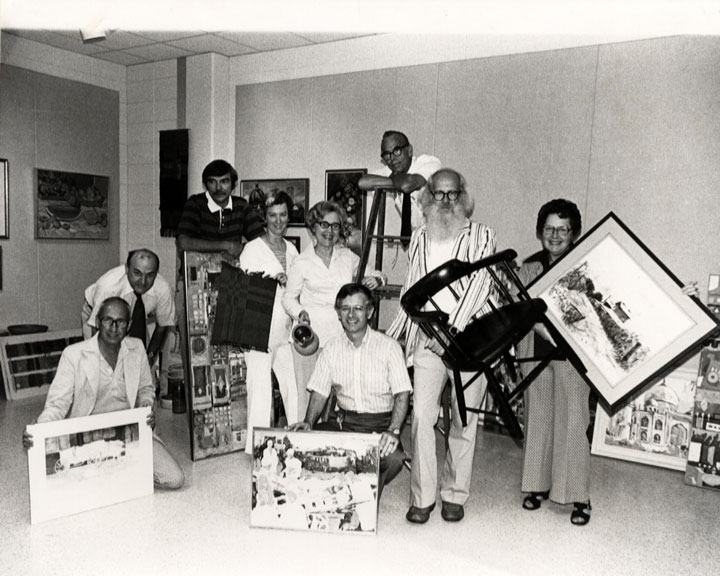
Lamar Dodd Collection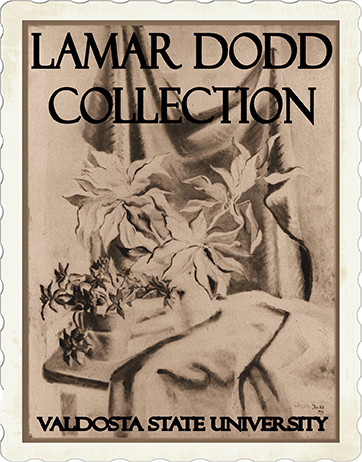
Lamar Dodd was not just the owner of most of the works in this collection that bears his name, but had personal links with several of the artists. He was a student of Jean Charlot at the Art Students League, he summered with Emil Holzhauer and Ferdinand Warren at Monhegan Island, Maine, and he encouraged Carl Holty , Ferdinand Warren, James Chan Leong and Jean Charlot to join him at the faculty of the University of Georgia, which resulted in permanent benefits to their careers and in one case, to another college in the state. In the wider realm of the art world, his legacy is two-fold: he left a rich body of work extending over decades that depicts everyday life in Georgia, and through his skill as an administrator and his eye for recruiting talent, he built the art department of the University of Georgia into one of the largest and most comprehensive in the United States, an effort that the University memorialized by naming the department the Lamar Dodd School of Art in his honor. He has also been described as “the most influential Georgia artist of his generation.”
Lamar Dodd was born in Fairburn and began his artistic training at LaGrange College, then a women’s college, at the age of twelve when he made a deal with the Dean for art lessons in exchange for shoveling coal and other chores. He studied briefly at Georgia Tech before going to the Art Students League in New York, where he studied with George Luks, an adherent of the Ashcan School, a movement that flourished in the first decade of the twentieth century and concentrated on depicting daily scenes of real life in sober colors. He was also influenced by John Steuart Curry and 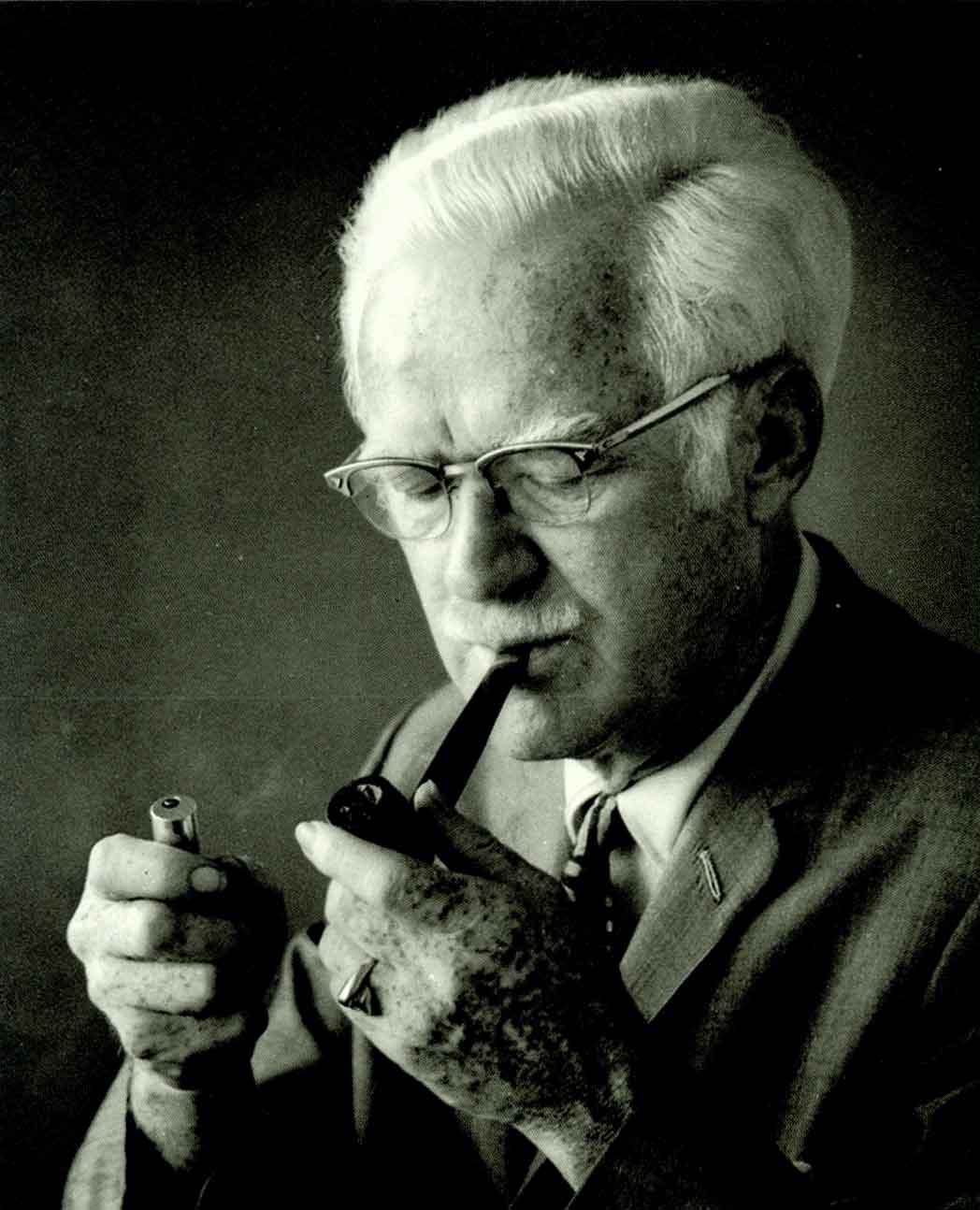 Thomas Hart Benton, who also celebrated American themes in their work. Upon returning South, he followed these principles in his own work, which showed the landscapes, history, and people of his region to such an extent it was noticed by a reviewer in his first show in 1932. In 1937, as part of a national movement to get working artists into universities, Dodd was appointed to the faculty of the University of Georgia. Within three years he had not only consolidated all the visual arts into one department, but he had started a master’s program. He would remain there till his retirement as head of the department in 1976.
Thomas Hart Benton, who also celebrated American themes in their work. Upon returning South, he followed these principles in his own work, which showed the landscapes, history, and people of his region to such an extent it was noticed by a reviewer in his first show in 1932. In 1937, as part of a national movement to get working artists into universities, Dodd was appointed to the faculty of the University of Georgia. Within three years he had not only consolidated all the visual arts into one department, but he had started a master’s program. He would remain there till his retirement as head of the department in 1976.
Although he continued to paint scenes of his native state, his subject matter expanded as he ranged further in his travels. In the 1940s, he began summering at Monhegan Island, Maine, adding the Maine coast as a source of inspiration, and in the 1950s, he began traveling abroad, first to Europe, where he studied the old masters and his more recent predecessors such as the Impressionists and Cezanne and painted European landmarks. He was later appointed by the State Department as a Cultural Emissary, and in that capacity visited Asia, the Middle East, and the Soviet Union.
The next two decades of his career saw a radical shift in subject matter: in 1963, Dodd was named as the official artist by NASA on the Mercury Astronaut-9 project and also served as a NASA artist for many other launchings including Apollo 9. Some of his works were done as triptychs, with a bold, expressionist style, and in some cases using black and white to depict lunar glare against the darkness of space. In 1978, inspired by his wife’s open heart surgery, he did a series called “The Heart”, which the surgeon asked him to do in the operating room to capture the dramatic immediacy of the procedure, as well as the realistic details of the procedure. In preparation for the series, Dodd did extensive reading and interviewed physicians, spending eight years on the project, and producing sixty paintings done in an abstract realist style, using circular shapes and religious symbolism.
The last ten years of his life saw a return to the local scenes of his youth, but with a changed style. Gone were the somber colors and realistic look in oil; instead he worked in watercolor in short, bright crisp strokes of color. The coastal shores around Monhegan Island were once again a favored subject, as well as familiar landscapes in Europe and the United States, but a year before he died he showed he was still in touch with the times by painting a picture of O.J. Simpson’s bloody glove in a highly abstract style.
Featured Artists of the Lamar Dodd Collection
- George Ayling, Ships at Dock
- Howard Nortan Cook, Waterfall
- Emil Eugen Holzhauer, Mañana, Mohegan Island Maine
- James Chan Leong, Seriograph on Plexiglass
- Ferdinand Warren, Wolf Fork Valley
- Carl Holty, Circus Horses
- Jean Charlot, The Mother and Child
- Irene Dodd, Sunset Cove, Watery Surf, and Tenant Harbor Maine
- Akira, Sodom
- Utagawa Kuniyoshi, Ten Day's Raid
- Hoshi Joichi, Tall Tree Top Blue
- Jack Coughlin, Tiger
- Rudi Pozzatti, Owl
- Kathe Killwitz, Ende
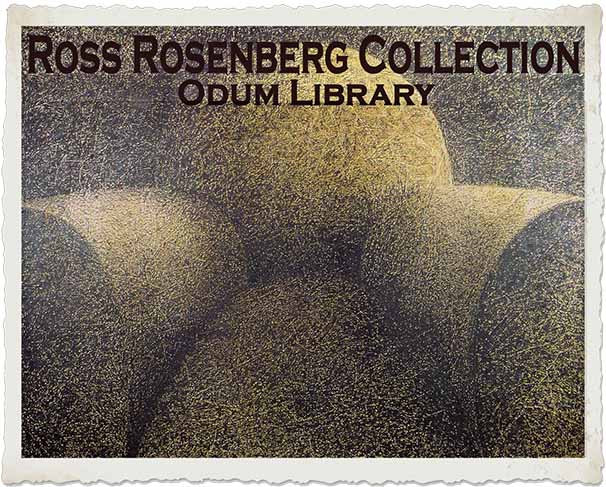 Ross Rosenberg Exhibit
Ross Rosenberg Exhibit
Ross Rosenberg was born in Syracuse, New York in 1941. he grew up in Rochester, NY, and attended the University of Michigan, graduating with a degree in English Literature and Art History. From that time until now, he has lived and worked in New York City. He studied drawing at the University of Michigan, drawing, painting, and sculpture at Parsons, drawing and printmaking at the School of Visual Arts, and papermaking at Dieu Donné. His work is in corporate and public collections, including the New York Public Library, and here, at Valdosta State University. His work was first displayed at Valdosta State University in a VSU Art Gallery Show “Works on Paper” and several of his smaller works were purchased at that time. Mr. Rosenberg has exhibited around the country and his large drawings series, of which this is a selection, were exhibited previously at MIT in Cambridge, MA, and at various exhibits in New Jersey, New York and Connecticut.
Mr. Rosenberg as described his large drawings and sculptures:
I am drawn to commonplace subjects such as chairs and houses because they are comfortingly familiar but at the same time they allow me to express feelings of mystery and foreboding. It is the ambiguity that involves me.Most of the images are based on early childhood memories. The rounded chair, for example, comes from a memory of being in a dark living room at night. There is a dim light coming from down a long hall. I hear someone in the hall and I climb up onto the chair and hide between the arms on the seat.The upright chair image is connected to the memory of watching my father making a chair for me when I was four years old. When I sat in it, my back rested against its back, my seat on its seat, my legs by its legs. Now I am both the chair and the one who makes the chair.So although I do not work from a conscious program or a theoretical base, there are clear emotional lines running through all of my work.
PAINTINGS
The paintings of this rounded chair are seen from a child's eye level and they put an adult in the same size relationship to the chair in the painting that a two-year-old has to a real one. As this series developed, I began to focus more and more on discovering different ways to create texture. So some of them are as much about how they were made as why they were made.
SCULPTURE
 When small children sit in an overstuffed chair, the experience is like that of being held by an adult. The seat is like a lap, the child leans back against the chair and is held by the chair's arms. The chair sculptures were created with the intention of emphasizing this relationship between the chair and the human body.
When small children sit in an overstuffed chair, the experience is like that of being held by an adult. The seat is like a lap, the child leans back against the chair and is held by the chair's arms. The chair sculptures were created with the intention of emphasizing this relationship between the chair and the human body.
According to an art critic, writing about Mr. Rosenberg’s works in the “Great Big Drawings” Show at MIT in 1982,
Ross Rosenberg’s dark, rolling contours suggest a cold and vacant nocturnal landscape; only gradually do they reveal themselves as the plump, domesticated curves of an overstuffed armchair. The artist is interested in conveying not the profile of a friendly and familiar household object, but instead, with the scale dislocation of a nightmare, the disquieting invitation of this dark…maternal embrace. (Kathy Kline, “Great Big Drawings,” Hayden Gallery, Massachusetts Institute of Technology, 1982)
Mr. Rosenberg donated his large drawings to Valdosta State University Archives and Special Collections in 2008-2009. You may see photographs of all his collected works owned by the VSU Archives and Special Collections in our Archon System at http://www.valdosta.edu/library/find/arch/findingaids/index.shtml , by searching under Rosenberg.
The VSU Archives and Special Collections and Odum Library are glad to share these canvases, drawings, and sculptures with the campus community. Over the last three years, we have spent a lot of time with these pieces, cleaning them, cataloging, photographing, and describing them, researching them, and getting them ready for exhibit. When we first opened the big shipping crates our reaction was “Chairs, and they are really big.” As we unrolled, cleaned and photographed them, we were struck by the “weirdness” of them, and the up-close impression of a lot of paint. The longer we lived with them, the more they captured our imagination. We realized why they were so big—to simultaneous evoke childhood safety and vulnerability, we needed to be small in relation to them. And we realized that we could never really see them in the tight photographs we took—we were photographing in a relatively small room—or standing over them spread out on the floor. We were glad to be able to create this exhibit on the large walls of the library, and it was not until they were hanging that we could fully appreciate all the facets of these “Great Big” works.
We thank Ross Rosenberg for donating his works, both large and small, and we thank the Valdosta State University Art Funding Pool committee for funding some framing and stabilization of the collection. Carla Penny of Classic Art and Frame was invaluable in helping us decide how to hang such large canvases. VSU Carpenters hung all the pieces and built the sculpture bases. The Odum Library Art Committee, Deborah Davis, Chair, Denise Montgomery, Julie Bowland, Stacey Wright, and Elizabeth Barwick designed and researched all the exhibits. VSU Archives and Special Collections Student workers assisted with cleaning paintings and sign layout. We hope you enjoy these works.
Dream Series:
Ross Rosenberg’s Dream Series Drawings came about through a happy accident. One day he was designing a large drawing, and he was going to draw it out on a small scale first. So he took some paper (Strathmore 400 Series Drawing Paper) and began laying down a ground—lightly shading an area with graphite. As he shaded, he noticed something that looked like eyes coming through from the texture inherent in the paper. Then he drew what he saw there. The Dream Series is an exercise in “stream of conscious” drawing and texture. The faces, the animals, the faces turning into animals, all emerged from slight differences in the texture of the paper which he then accented. Rosenberg said that whenever he tried the make the process thoughtful, and perhaps fill in a blank spot, the drawing failed. Compare these small bits of texture study with the large paintings, also texture studies, hung on the 1st floor of the psychology building.
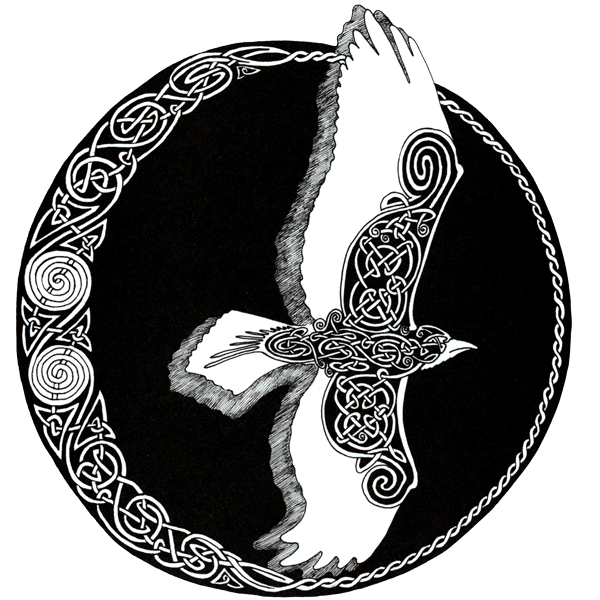 Elantu Veovode
Elantu Veovode
Art and nature have been important to me since I was a small child. I was born in Two Grey Hills, New Mexico and grew up in Colorado, New Mexico and British Columbia with forays into San Francisco and Montreal, among others. I bought my first book on art when I was eight years old – I still have it. My mother helped by buying me quality art supplies and leaving me alone with them.
My paintings incorporate influences from direct family culture: Russian mother and Welsh-Arapahoe father as well as Tlingit and Kwakaital near relatives, not to mention a wealth of Navajo friends and the influence of the Middle Eastern and Indian cultures where my mother lived for nearly twenty years. She arrived in America two years before I was born.
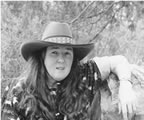 My work focuses on the bonds of life to life, expressed in my paintings through the framework of Celtic Knotwork, liberally interpreted with the help of Non-Linear equations (my other passionate love), summation series mathematics- expressed in the forms of the golden section – and string theory physics. These are the tools that I use that allow me to embrace the divinity of nature and to translate into paint and pencil the awe it inspires in me.
My work focuses on the bonds of life to life, expressed in my paintings through the framework of Celtic Knotwork, liberally interpreted with the help of Non-Linear equations (my other passionate love), summation series mathematics- expressed in the forms of the golden section – and string theory physics. These are the tools that I use that allow me to embrace the divinity of nature and to translate into paint and pencil the awe it inspires in me.
The paintings are planned using a piece of string with knots tied in relationship distances. They are hand drawn in light blue pencil and enhanced with pen & ink. Finally, watercolor, ink wash, colored pencil and sometimes guache, wax and crayons are added. Sometimes gold leaf is applied. I’ve even gone so far as to stand a candle on my head and paint with smoke.
The Mandala pieces are braided in a circle – Celtic style – in which the visible cords take turns passing over or under one another so that no one element is dominant. I especially like doing this with prime numbers.
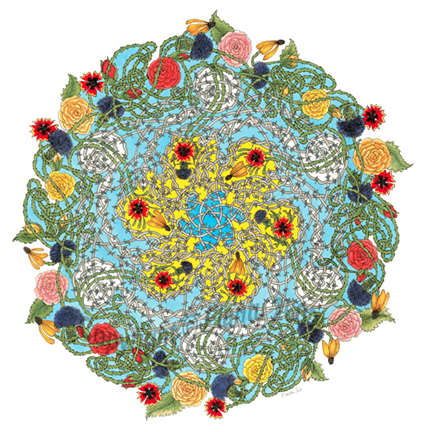 The majority of the abstracts are the product of synesthesia, a condition in which the senses overlap. In my case, I see sounds. Gets confusing sometimes but I cope because its pretty and I’m used to it. I also do a number of portraits, nudes and drawings from nature.
The majority of the abstracts are the product of synesthesia, a condition in which the senses overlap. In my case, I see sounds. Gets confusing sometimes but I cope because its pretty and I’m used to it. I also do a number of portraits, nudes and drawings from nature.
Listening to music while contemplating my work is a good idea. I always listen to music when I’m painting. The flow wakens the mind and allows it to wander. Personally, I have an eclectic taste in music and listen to everything from Ragas to Opera and even Bluegrass. With these pieces I would recommend something that leans heavily on the mathematical content in the music like a Raga or Scheherazade by Rimsky-Korsakov. If you’re inclined to the romantic, a Ghazala by Najma is good or anything on any album by Lorenna Mckinnett. Myself, I listen to Pederewsky when I paint, but I admit that he is hard to find in this country.
I had my first showing at a gallery in 1967. I was 17 years old at the time. Since then, I have shown in a variety of cities in the U.S. and Canada: Washington; Boston; Los Angeles; San Francisco; Seattle; Denver; Santa Fe; Austin; Vancouver and Toronto. I was invited to hang two pieces in the Helen Day Museum in Vermont and won first prize in traditional Celtic Art two years in a row in international competition in Toronto.
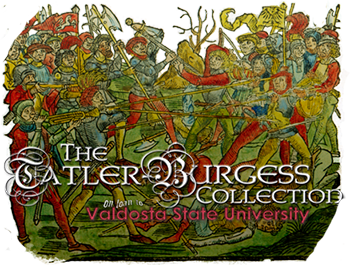 Tatler-Burgess Collection
Tatler-Burgess Collection
The Tatler-Burgess Collection is the fruit of many years of work. This exciting library of pieces, some of which, dating back to the middle of the 15th century – woodcuts by Albrect Dürer and others offers glimpses of the artistic taste of the late medieval/early renaissance period.
The collection boasts rarities of unsurpassed quality such as a leaf from the Saxon Chronicles; leaves from Sebastian Brandt’s Ship of Fools, a very popular allegorical work in its day, depicting frowned upon vices and sins.
Those interested in printing history will enjoy incunabula; leaves from various important bibles and other works; woodcuts, copperplate and steel engravings as well as lithographs. Scholars will be able to compare works spanning hundreds of years and covering diverse topics and will be given the opportunity to handle work not normally found outside of museums or major collections.
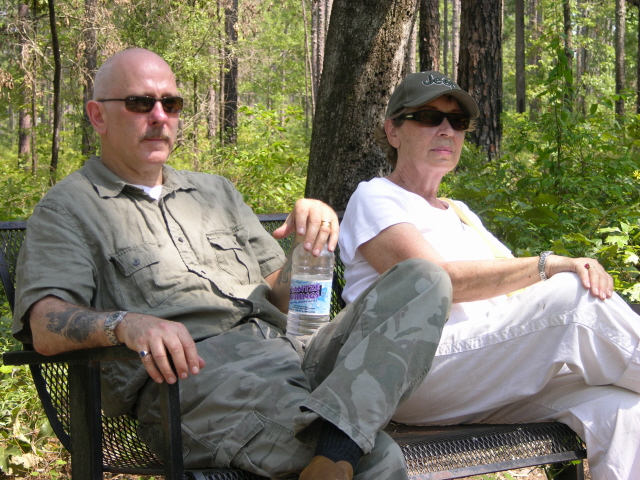 Visitors will be able to enjoy many antique maps some by important cartographers such as Blaeuw, Bonne and Vaugondy. Research carried out by Douglas Carson, a History Major senior will help us understand the salience of some of the pieces shown.
Visitors will be able to enjoy many antique maps some by important cartographers such as Blaeuw, Bonne and Vaugondy. Research carried out by Douglas Carson, a History Major senior will help us understand the salience of some of the pieces shown.
Artists under us will not be disappointed either; with Albrect Dürer, Virgil Solis, Hans Springklee being represented alongside work by Picasso, Matisse, Dufuy, Bonnard, and Maillol.
This is an exciting opportunity to be able to study important and rare works spanning over 500 years of printing history.
Rembrandt & Dali Collections
Destino - Salvador Dali
The six-minute short follows the love story of Chronos and the ill-fated love he has for a mortal woman named Dahlia.[1] The story continues as Dahlia dances through surreal scenery inspired by Dalí’s paintings. There is no dialogue, but the soundtrack includes music by the Mexican composer Armando Dominguez. The 17-second original footage that is included in the finished product is the segment with the two tortoises (this original footage is referred to in Bette Midler’s host sequence for The Steadfast Tin Soldier in Fantasia 2000, as an “idea that featured baseball as a metaphor for life”) – Wikipedia.
Rembrandt van Rijn - Netherlands, 1606-1669
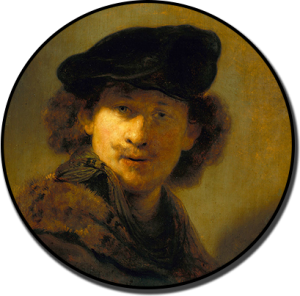
As the youngest son of a miller, Rembrandt van Rijn was free of the obligation to follow the family trade and was able to spend seven years in Latin school and go on to study at the University of Leiden, but soon left, according to his first biographer, because “by nature he was moved toward the art of painting and drawing”1. After three years of study with Jacob Isaacsz van Swanenburgh and six months tutelage in Amsterdam with the finest historical painter of that era, Pieter Lastman, he returned to Leiden and was soon sought after as a portraitist and history painter. By 1631 he established a studio in partnership with art dealer Hendrik van Uylenburgh,
who arranged commissions, and he also taught students as well. He married van Uylenburgh’s niece Saskia in 1634; the couple had four children, only one of whom, Titus, survived infancy, and Saskia died in 1642, the same year he painted his most famous work, the large mural, Night Watch.
His life became increasingly unsettled. A house he had purchased in 1639 at the height of his success drove him into debt that eventually forced him into bankruptcy, forcing the sale of his estate, including his art collection. After his wife’s death, he had taken up with his son’s nursemaid, Geertje Dirckx, then dismissed her and became involved in 1649 with Hendrickje Stoffels, by whom he had a daughter, Cornelia, in 1654. Because they were unmarried, she was summoned before a council of the Dutch Reformed Church and censored for having “lived with Rembrandt like a whore”2, but they remained together until her death in 1663.
Both his domestic scandals and general changes in artistic styles, which did not focus on personal aspects of their subjects as Rembrandt did, affected his patronage. He received fewer commissions and no students are known to have worked with him in the 1650s, and only one in the 1660s. His assets declined further due to the rejection of his work and the deaths of Hendrickje Stoffels and his son Titus, who had set up a business partnership to protect him financially. He died in 1669, and Rembrandt was buried in a rented grave, which has since vanished in Westerkerk, Amsterdam.
As an artist, Rembrandt had parallel careers as painter and printmaker, but he seldom depicted the same subjects in both media, and only rarely did he convert his paintings into prints.
He often used ordinary materials in unusual ways, and also experimented with his copper plates to obtain different printed images. He was also among the first printmakers to use various kinds of the newly available Asian papers to achieve different effects. As a result, he is still a highly important influence upon printmakers who are working today.
- Wheelock, Arthur k., Jr. “Rembrandt van Rijn.” National Gallery of Art. 2014. Web. 28 September 2015. <http://www.nga.gov/content/ngaweb/Collection/artist-info.1822.html?artobj_artistId=1822&pageNumber=1>
- Ibid.
 The Kessler Collection
The Kessler Collection
Jeannette and Charles Kessler have given the VSU Archives and Special Collections over fifty items from their extensive travels in East Asia. Items include Bainchiang Pottery-from 1000 to 3000 years old, woven antique textiles from Thailand, Indonesia, Loas, Cambodia, and other countries, and a collection of Tibetan photographs. Jeannette was a teacher and Charles was an accountant who worked and then traveled in East Asia in the 1980s-2000s. Their valuable and large collection represents an exciting gift for the VSU Archives.
Charles Kessler made several trips to Tibet in 1999 and 2000. Kessler, an amateur photographer, was fascinated by the people he met there and created a photography exhibit, “Faces of Tibet” which has been exhibited in galleries previously. These are 15 of the 67 images from that exhibit. The photographs were taken with a Leicha M6 Camera on his travels.
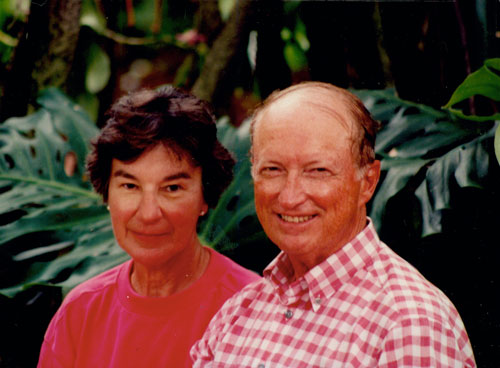 Jeannette Kessler was an avid collector of antique textiles. Some pieces she bought to show and some she had made into clothes. In all, over 60 textiles from South East Asia are part of this collection. The seven shown here are mainly Indonesian IKAT weavings, ranging in age from 100 to 15 years old. See the signs written by Elantu Veovode, an artist, and weaver who has recently relocated to Valdosta to understand the meaning and techniques of IKAT weaving.
Jeannette Kessler was an avid collector of antique textiles. Some pieces she bought to show and some she had made into clothes. In all, over 60 textiles from South East Asia are part of this collection. The seven shown here are mainly Indonesian IKAT weavings, ranging in age from 100 to 15 years old. See the signs written by Elantu Veovode, an artist, and weaver who has recently relocated to Valdosta to understand the meaning and techniques of IKAT weaving.
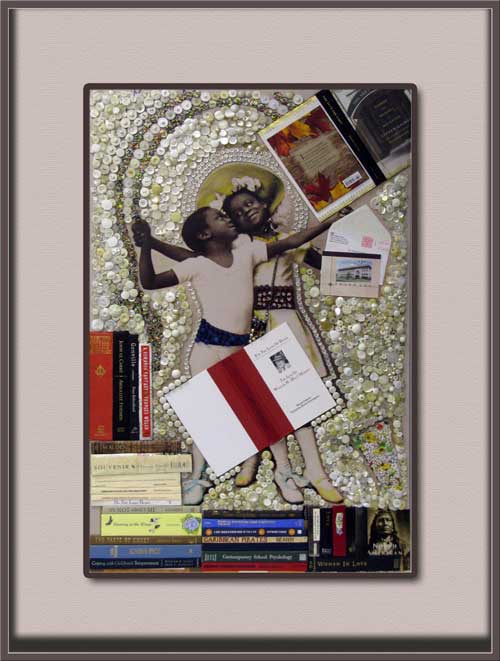 Amalia Amaki, For the Love of Books
Amalia Amaki, For the Love of Books
 Amalia Amaki is an artist, art historian, writer, film critic and visual studies scholar. She is currently an independent artist. Previously she was the professor of Art, Art History and Visual Studies at the University of Alabama, having previously taught at the University of Delaware, North Georgia College and State University, and Spelman College. She has exhibited work in over thirty one-person shows, including a retrospective at the National Museum of Women in the Arts (Washington, DC, 2005), and more than 100 group exhibitions throughout the United States and in Europe, Africa, and South America, most recently in Paris, France (2010). She has been a National Endowment for the Arts fellow; an artist grant recipient from the Georgia Council for the Arts, Fulton County Arts Council and the City of Atlanta; and has received commendations for her contributions to the arts from Georgia Secretary of State Lewis Massey, Governor Sonny Perdue, and First Lady Laura Bush.
Amalia Amaki is an artist, art historian, writer, film critic and visual studies scholar. She is currently an independent artist. Previously she was the professor of Art, Art History and Visual Studies at the University of Alabama, having previously taught at the University of Delaware, North Georgia College and State University, and Spelman College. She has exhibited work in over thirty one-person shows, including a retrospective at the National Museum of Women in the Arts (Washington, DC, 2005), and more than 100 group exhibitions throughout the United States and in Europe, Africa, and South America, most recently in Paris, France (2010). She has been a National Endowment for the Arts fellow; an artist grant recipient from the Georgia Council for the Arts, Fulton County Arts Council and the City of Atlanta; and has received commendations for her contributions to the arts from Georgia Secretary of State Lewis Massey, Governor Sonny Perdue, and First Lady Laura Bush.
Amalia Amaki has been awarded art commissions from the Atlanta Committee for the Olympic Games, US General Services Administration - Sam Nunn Federal Center, The Coca-Cola Company, Coca-Cola Enterprises, Hartsfield-Jackson International Airport (3), The Contemporary (formally Nexus Contemporary Art Center), Seagram’s Gin, Miller Brewing Company and Absolut Vodka. Her work is in the permanent collections of the National Museum for Women in the Arts (Washington, DC); High Museum of Art; Museum of Fine Arts, Houston; and the Albany Museum of Art among many others. Amaki’s publications include Hale Woodruff, Nancy Elizabeth Prophet and The Academy (2007 with A. Barnwell-Brownlee) and A Century of African American Art: The Paul R. Jones Collection (2004), and has contributed essays to numerous anthologies and art journals. She is currently writing a pictorial history of Tuscaloosa, Alabama for Arcadia Publishing, and has a forthcoming book of artwork and poems, Homage, with Marquand Books.
Valdosta Artists
The third floor of Odum Library is devoted to local artists from Valdosta and the surrounding region. This collection represents a wide range of artistic mediums that span from oil paintings to digital art and showcases the amazing talent in South Georgia. Click on the artists below for more information.
Alli DelleDonne | Julie Bowland | Leon Colvin | Authur Deshaies | Elantu Veovode | J. Stephen Lahr | Courtney Page Hackett | Irene Dodd | Thomas Andrew Larson | Tom Lundquist | John Kolb McIver | Earle McKey III | Joseph W. Pember | Dan Puissegur | Andrew Tatler-Burgess | Joe W. Taylor | Ronald Zaccari
The Songye African Art exhibit is on the third floor of Odum Library. It features authentic antique Songye artwork as well the artwork of Elantu Veovode.
Community Feedback
"Having art in a public place such as a library that is used for education and study brings a peaceful mood to the library. It opens the mind and can allow students to look at studying as well as all other things and be able to think out of the box and help with understanding underlying things
-VSU Student
"I feel like having art in a place of study actually brings some peace and tranquility to my studies. Sometimes, I will be concentrating so hard on my homework that I need something to take my mind off of it before I go crazy. It's really nice to be able to look up and see something that makes me think of something else besides homework."
-VSU Student
"Striking, Passionate."
-VSU Staff
We want to hear from you! Please fill out our Art in Odum survey and tell us what you think.
Archives & Special Collections
-
William H. Mobley IV Reading Room
Odum Library
1500 N. Patterson St.
Valdosta, Ga. 31698
archives@valdosta.edu -
Mailing Address
1500 N. Patterson St.
Valdosta, GA 31698 - Phone
- Phone: 229.333.7150
- Archivist
- Phone: 229.259.7756
Monday - Thursday
9:00am-5pm
Friday
9:00am-3pm
